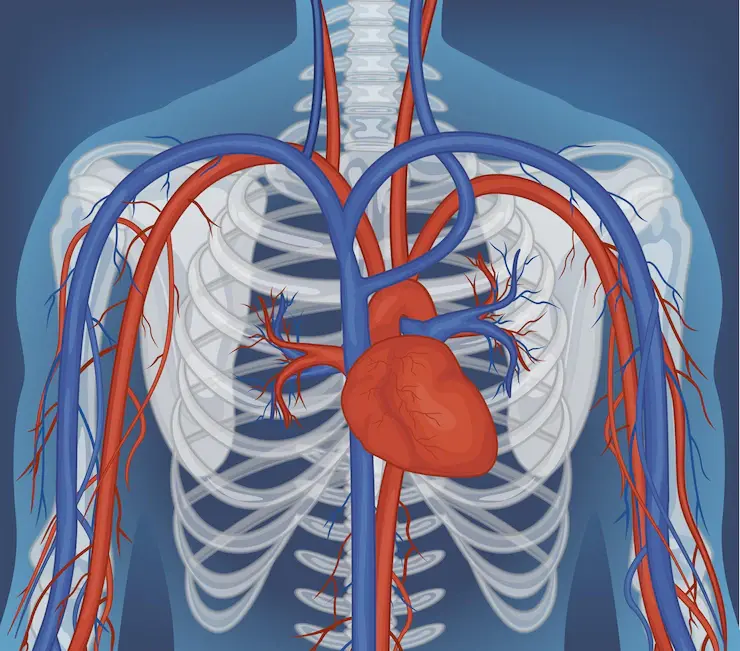Preventive Healthcare
Blood Vessels: Types, Functions and Anatomy
21170 Views
0

Overview of blood vessels
Blood vessels are essential components of the circulatory system, responsible for transporting blood throughout the body. They form a complex network that reaches every organ and tissue, ensuring they receive vital nutrients and oxygen while removing waste products. Read this blog until the end to get a clear understanding of blood vessels' meaning.
The different types of blood vessels
- The human body is a complex system comprising various organs and tissues that work together to ensure proper functioning. One crucial component of this intricate network is the blood vessels. These remarkable structures carry blood throughout the body, supplying oxygen and nutrients to every cell.
- There are different types of blood vessels, each serving a specific purpose. Arteries are thick-walled tubes that transport oxygenated blood away from the heart to various parts of the body. They have a robust structure to withstand the high pressure exerted by the pumping heart.
- On the other hand, veins are responsible for carrying deoxygenated blood back to the heart. Unlike arteries, veins have thinner walls and contain valves that prevent the backward flow of blood.
- Capillaries are tiny, hair-like vessels connecting arteries and veins. Their thin walls allow for gas exchange between cells and the bloodstream.
Anatomy of blood vessels
The anatomy of blood vessels is a complex and intricate system that plays a vital role in our overall health. These amazing structures are responsible for transporting oxygen, nutrients, and waste products throughout the body. Understanding their anatomy can help us appreciate just how important they are.
Blood vessels consist of three main layers: the tunica intima, tunica media, and tunica adventitia. The innermost layer, the tunica intima, is composed of endothelial cells that provide a smooth surface for blood flow. The middle layer, the tunica media, contains smooth muscle fibres that regulate vessel diameter and blood pressure. The outermost layer, the tunica adventitia or externa, provides support and protection to the vessel.
- Arteries have thicker walls compared to veins due to their higher-pressure environment. They also have elastic fibers in their walls which allow them to withstand high pressures generated by each heartbeat.
- Veins have thinner walls but larger lumens as they carry deoxygenated blood back toward the heart.
- Capillaries are tiny microscopic vessels that connect arteries with veins at the tissue level. Their thin walls facilitate the exchange of gases and nutrients between blood and surrounding tissues.
Understanding this basic anatomy can help us recognize signs or symptoms related to vascular conditions such as aneurysms or blockages in specific areas of our bodies.
The function of blood vessels
Blood vessels play a vital role in maintaining the proper functioning of our bodies. They serve as a complex network of tubes that transport blood throughout our system, delivering oxygen and nutrients to every cell and removing waste products.
- One of the main functions of blood vessels is to regulate blood flow. Arteries carry oxygen-rich blood away from the heart to various organs and tissues, while veins bring deoxygenated blood back to the heart. Capillaries, on the other hand, connect arteries and veins, allowing for the exchange of substances between cells and surrounding tissues.
- In addition to regulating blood flow, blood vessels also help maintain optimal blood pressure. This is achieved through their ability to dilate or constrict when needed. When we engage in physical activity or experience stress, for example, certain hormones are released that cause our arteries to narrow temporarily to increase resistance against the flow of blood.
- Furthermore, another important function of these remarkable structures is thermoregulation. Blood vessels near the surface of our skin can expand or contract depending on environmental conditions to release or retain heat respectively.
- It's clear that without properly functioning blood vessels, our bodies wouldn't be able to perform essential tasks such as providing sufficient oxygenation and nutrition to all cells must take care of our cardiovascular health by adopting a healthy lifestyle that includes regular exercise, a balanced diet high in fruits and vegetables, avoiding smoking and excessive alcohol consumption.
Common conditions associated with blood vessels
Blood vessels can also be susceptible to various conditions that affect their structure and function. Understanding these common conditions is essential for maintaining optimal vascular health.
- One such condition is atherosclerosis, which occurs when fatty deposits build up on the walls of blood vessels, narrowing them and restricting blood flow. This can lead to serious complications such as heart attacks and strokes.
- Another common condition is hypertension or high blood pressure. When the force of blood against the artery walls is consistently too high, it puts strain on the blood vessels and can eventually cause damage if left untreated.
- Varicose veins are another frequently encountered vascular problem. These are enlarged veins that appear swollen and twisted under the skin's surface. They often occur in the legs due to weakened valves within the veins themselves.
- Peripheral artery disease (PAD) affects the arteries outside of your heart and brain, typically occurring in your limbs. It causes reduced blood flow to these areas due to narrowed or blocked arteries.
- Deep vein thrombosis (DVT) refers to a clot formation within deep veins, usually in the legs or pelvis region. If not promptly treated, DVT can lead to a pulmonary embolism—a potentially life-threatening condition where a clot travels from its original site into an artery supplying the lungs.
Book Blood Test at Home
Conclusion
Blood vessels play a crucial role in our body's circulatory system. They come in three main types: arteries, veins and capillaries. Arteries carry oxygenated blood away from the heart to various parts of the body while veins bring deoxygenated blood back to the heart. Capillaries serve as the connection between arteries and veins, allowing for nutrient exchange. Understanding the anatomy and function of blood vessels is essential for maintaining overall health. However, certain conditions can affect these vital pathways, such as atherosclerosis, varicose veins and aneurysms. It is important to be aware of these conditions and take proactive steps to prevent them.
Consult a doctor for early detection of diseases and book your blood test with Metropolis Healthcare. Our world-class testing facilities and home collection of samples make it convenient for you to get an accurate diagnosis of diseases without having to wait too much. Get in touch with us to learn about everything we can do for you.























 WhatsApp
WhatsApp